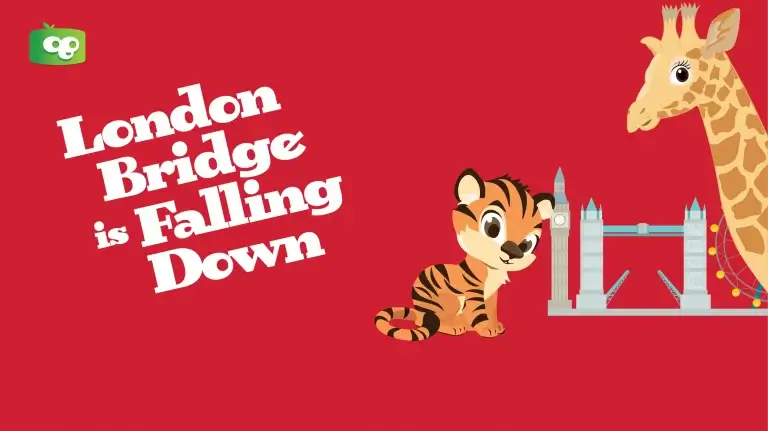

Nursery rhymes are a vital part of childhood development. They help children develop language skills, build their vocabulary, and improve their memory and listening skills. One well-known nursery rhyme is London Bridge Is Falling Down, which has a long and storied history. This blog post will delve into the past and meaning of this famous nursery rhyme and explore its popularity and use throughout the years.
The origins of London Bridge Is Falling Down are somewhat murky, but it is thought to have originated in the 12th century. According to some sources, the nursery rhyme may have been inspired by the collapse of London Bridge in 1014, or it could be a metaphor for the fall of the Roman Empire.
Other theories suggest that the nursery rhyme may be related to the Viking raids on England, or it could be a reference to the marriage of King Edward II to Isabella of France.
Regardless of its origins, “London Bridge Is Falling Down” has undergone several variations. In some versions, the nursery rhyme song is about the collapse of a bridge in France; in others, it’s about the destruction of a bridge in Scotland. Some versions also include additional verses or different lyrics entirely.
While “Mary Had a Little Lamb” offers many life lessons, there are other nursery rhymes that are equally rich in meaning and history. One such example is “London Bridge is Falling Down.”
Much like “Mary Had a Little Lamb,” the nursery rhyme “London Bridge Is Falling Down” has roots that are deeply embedded in history. The song is thought to refer to the various bridges that have been built and subsequently fallen or been replaced over the River Thames in London. Understanding the London Bridge song meaning can enrich your child’s appreciation for history and architecture, alongside their growing familiarity with the world of nursery rhymes.
When introducing your child to the “London Bridge Is Falling Down” nursery rhyme, it might be helpful to distinguish it from the iconic Tower Bridge, another famous London landmark. Despite common misconceptions, they are not the same structure. Nursery Tower Bridge isn’t typically the focus of any famous nursery rhymes but can be a fun way to teach your child about the various landmarks that make London a city of rich history and culture.
Your child might ask, “Is London Bridge falling down?” after hearing the nursery rhyme. This can be a great educational moment to discuss how preschool songs and stories often contain elements of exaggeration or symbolism. While the current London Bridge is structurally sound, the nursery rhyme likely refers to the historic challenges of maintaining a wooden bridge over the River Thames, which did require frequent rebuilding.
In today’s world, the “London Bridge Is Falling Down” rhyme is more than just a song about a crumbling bridge. The London Bridge falling down meaning can also serve as an allegory about the challenges and responsibilities that come with maintaining public works, structures, and communities. It offers a different set of lessons compared to “Mary Had a Little Lamb,” but it is just as important for a child’s holistic development.
By exploring both Mary Had a Little Lamb and “London Bridge Is Falling Down,” you not only expose your child to the world of nursery rhymes but also to the valuable life lessons that they carry. Whether it’s about friendship, history, or public responsibility, these songs remain an invaluable teaching tool for parents of young children.
The lyrics of London Bridge Is Falling Down are relatively simple but open to interpretation over the years. Some have suggested that the nursery rhyme is about the dangers of greed and the importance of working together to rebuild after a collapse.
Others have interpreted it as a metaphor for the fall of the Roman Empire or a great power’s failure.
The nursery rhyme shares themes with other popular nursery rhymes, such as Three Blind Mice and Hickory Dickory Dock, which also feature animals and objects (in this case, “my fair lady”) being chased or caught. These themes may be related to the dangers of being caught by a predator or the consequences of being caught in a trap.
London Bridge Is Falling Down has remained popular throughout the years and featured in numerous movies, TV shows, and commercials. It’s also a common choice for educators, who use it in preschool classrooms to teach children about language and rhyme.
The nursery rhyme is often accompanied by hand motions or other interactive elements, making it a fun and engaging way for children to learn.
The traditional nursery rhyme of London Bridge is Falling Down has been around for centuries and may date back to the Middle Ages. One explanation for the rhyme is that building a bridge across London’s River Thames was tough, and it kept falling.
It’s one of the most excellent educational app for kids and helps to teach kids about different cities and the concept of improving.
A lively rhyme, London Bridge is Falling Down, will teach your child several essential skills while allowing them to enjoy singing a nursery rhyme that children have sung for hundreds of years.
London Bridge Is Falling Down is a classic nursery rhyme with a rich history and multiple possible meanings. It’s been a popular choice for educators and featured in various forms of popular culture. While the origins and implications of the nursery rhyme may be debated, preserving and teaching these rhymes to future generations is essential.
They play a crucial role in child development and provide a fun and interactive way for children to learn the language and build their vocabulary. So next time you sing “London Bridge Is Falling Down” with your child or students, take a moment to appreciate the history and significance of this timeless nursery rhyme.




